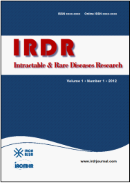Drug Discov Ther. 2015;9(1):70-74. (DOI: 10.5582/ddt.2015.01002)
Circadian rhythm of serum 25 (OH) vitamin D, calcium and phosphorus levels in the treatment and management of type-2 diabetic patients.
Masood T, Kushwaha RS, Singh R, Sailwal S, Pandey H, Varma A, Singh RK, Cornelissen G
The circadian time structure of serum 25 (OH) vitamin D (25-OHD), calcium (Ca) and phosphorus (P) may prove to be helpful in prevention, efficacy and management of diabetes mellitus. Ten newly diagnosed patients with type-2 diabetes mellitus (6 men and 4 women), 30-65 years of age, and 10 age-matched clinically healthy volunteers (7 men and 3 women) were synchronized for one week with diurnal activity from about 06:00 to about 22:00 and nocturnal rest. Breakfast was served around 08:00, lunch around 13:30 and dinner around 20:00. Drugs/nutraceuticals known to affect the vitamin D-calcium metabolism and status were not taken. Blood samples were collected at 6-h intervals for 24 h under standardized, 24-h synchronized conditions. Serum 25-OHD, Ca, P, Ca-P product and Ca-P ratio were determined. A marked circadian variation was demonstrated for 25-OHD in healthy volunteers (p = 0.030) and of borderline statistical significance in the diabetic patients (p = 0.083) by population-mean cosinor analysis. Similarly, healthy volunteers showedmborderline significance for serum Ca, P and Ca-P ratio. The circadian acrophase of Ca occurred later in the patients as compared to healthy controls. Mapping the circadian rhythm (an important component of the broader time structure or chronome, which includes a.o., trends with age and extra-circadian components) of vitamin D and calcium is needed for exploring their role as markers in the treatment and management of diabetic patients.







